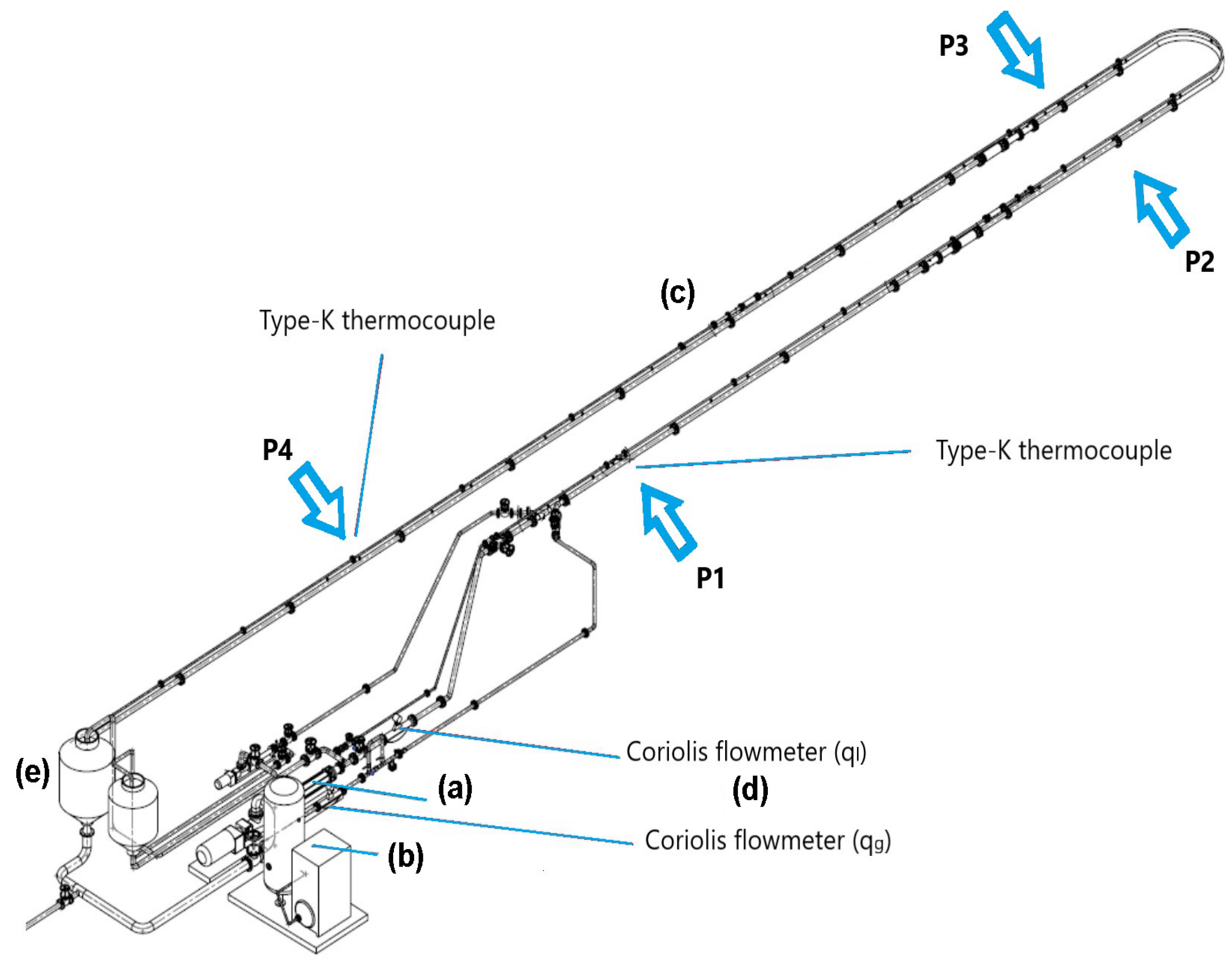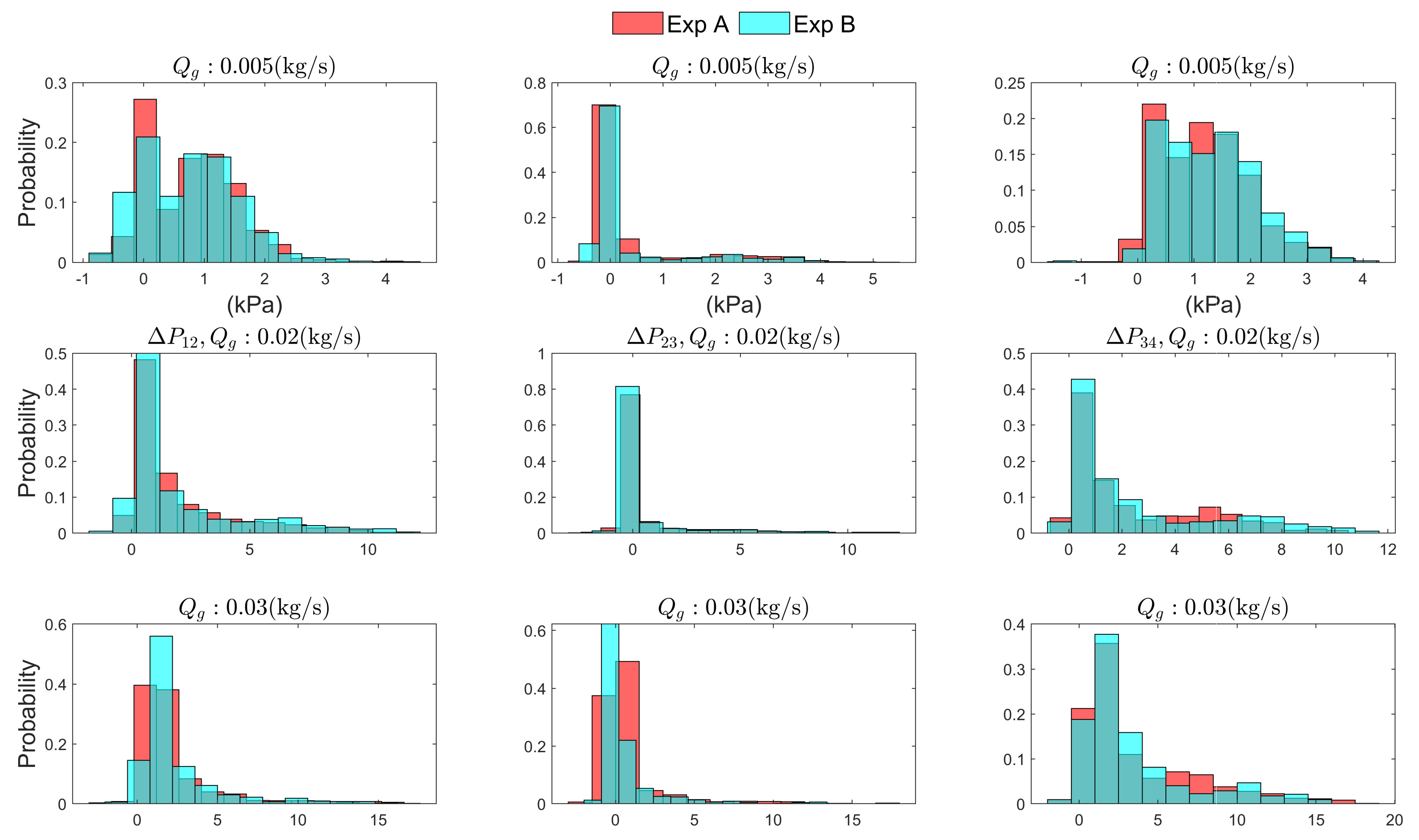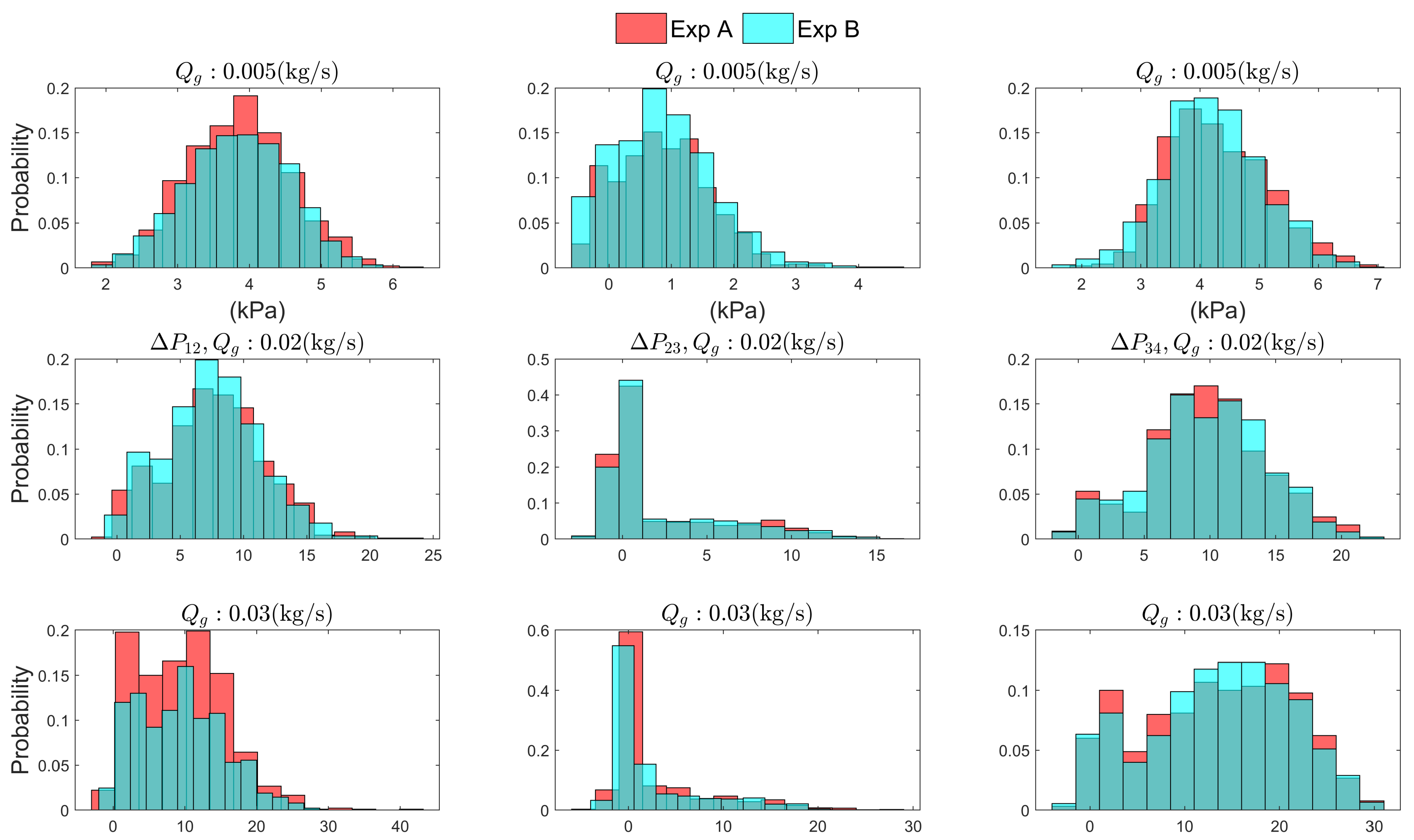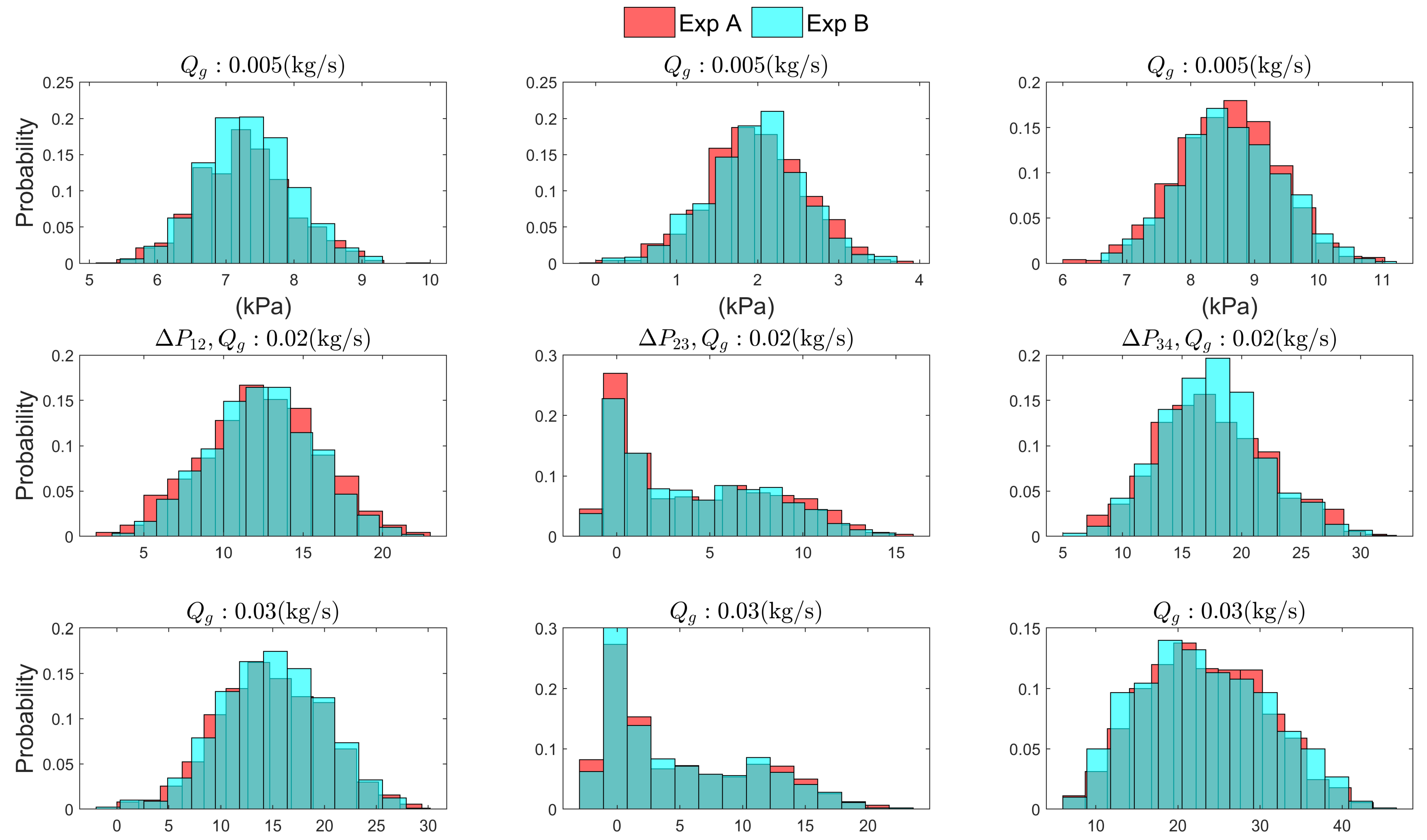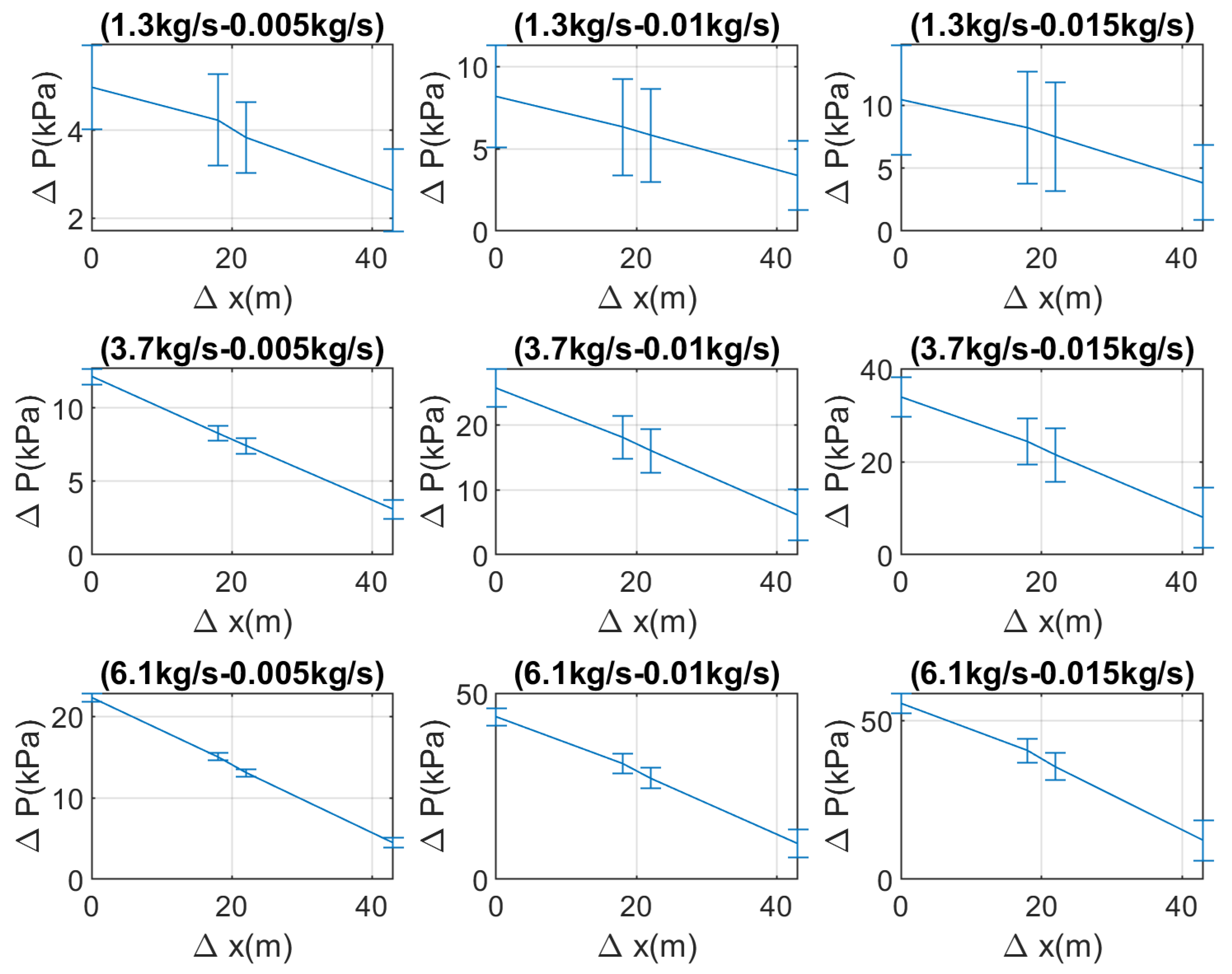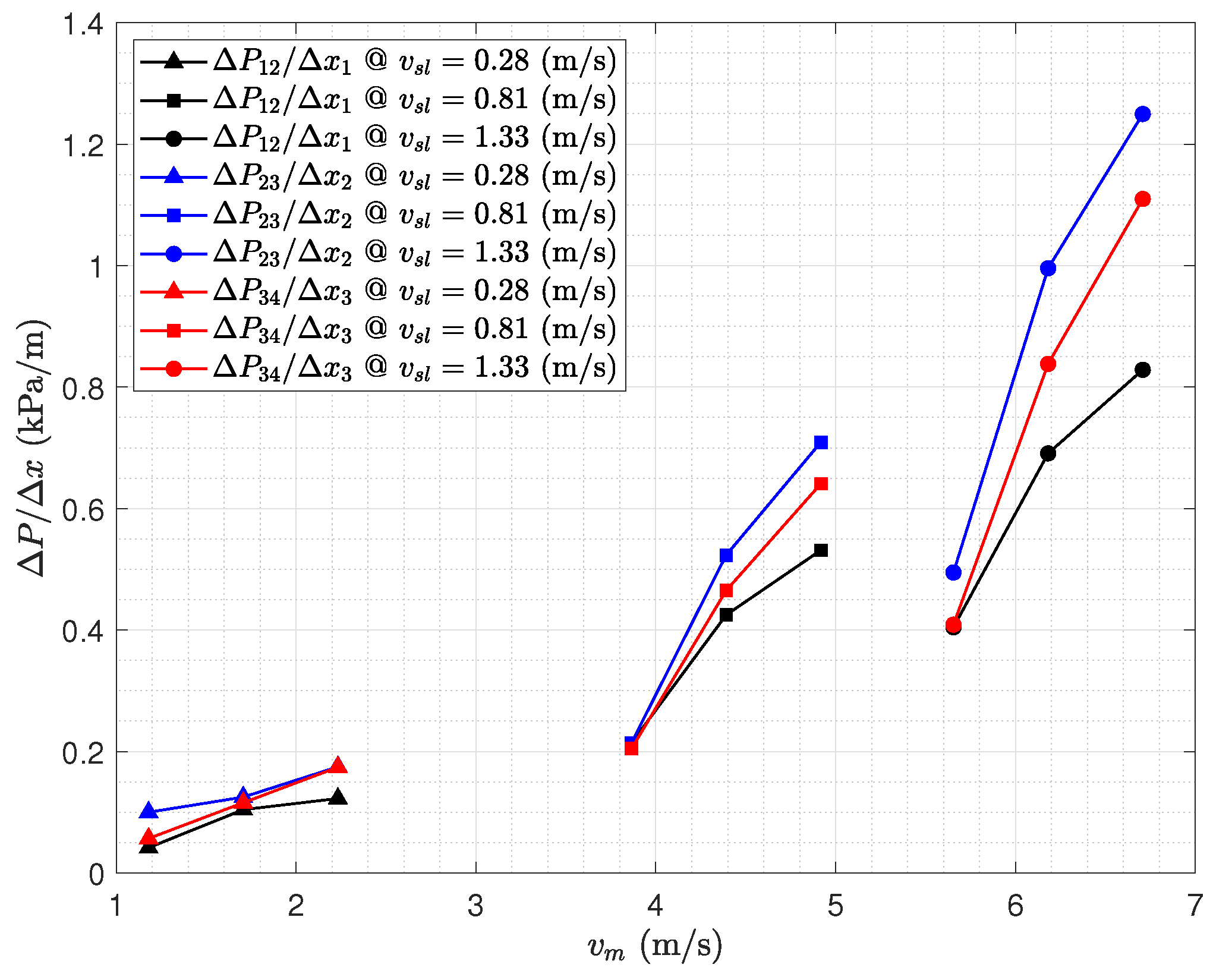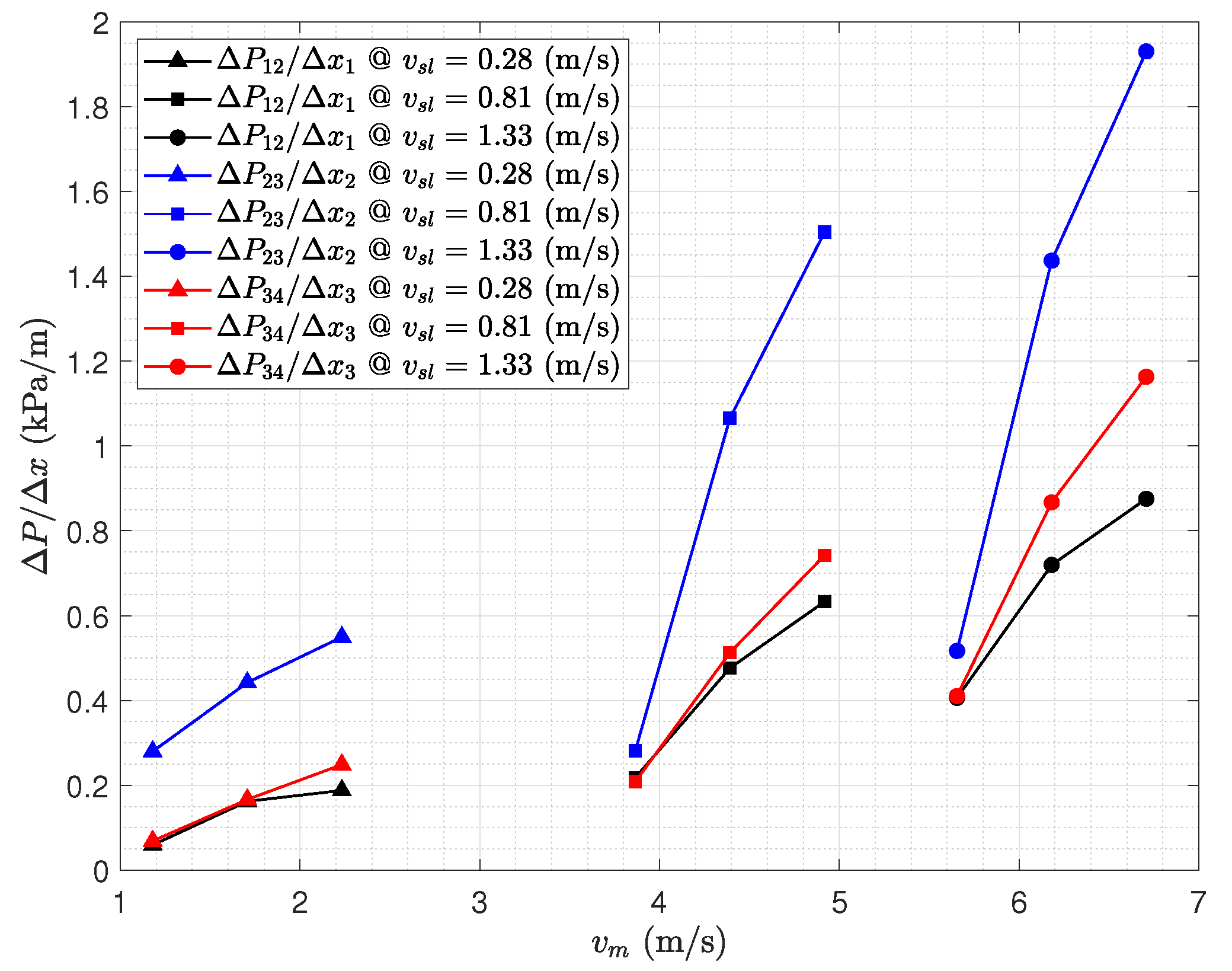The gas entrained at the mixing front leads to the formation of large bubbles within the slug, which are severely stretched as they are dragged along by the liquid (
Figure 3a,b). At the opposite end of the slug body, the trailing bubble penetrates the slug, thereby creating a persistently-thick layer of liquid around it (
Figure 3c). A combination of rounded and elongated bubbles coexist inside this layer, until the larger bubbles finally burst (
Figure 3d). Note that a number of smaller bubbles remain attached to the fluid layer. These specific traits are markedly different from those observed with low viscosity mixtures and, therefore, modify the nature of the pressure field. We analyze the pressure in the following sections.
3.1. Statistical Characterization of the Pressures
Figure 4,
Figure 5 and
Figure 6 show the general features of the pressure drop distributions. According to Akagawa et al. [
27], the (
) distribution depends on the length of the section where the pressure measurements are taken. Therefore, the data for
and
tend to have a similar behavior on the two long sections of the pipe, since
. However, the shapes of the
distributions in the
U-section of the pipe tend to be less distorted with higher flow rates (particularly for (
) kg/s and (
) kg/s, as
Figure 5 and
Figure 6 show). Apparently, the secondary flows induced by the centripetal acceleration of the mixture have a stabilizing effect.
The quantitative information obtained from these distributions is useful and provides an clearer overall picture.
Table 3 shows the mean pressure drop in the three sections of the pipe. As expected, the mean values rise when either of the two mass flow rates increases, with
causing a far more significant effect than
. If the pressure drops are normalized in terms of their maximum values registered in a particular section of the pipe, that is if
, then we observe: (a) an almost linear dependence of
on
and
, and (b) this linear dependence is approximately valid in all pipe sections (see
Table 4). Thus, in principle, this underlying pattern could be conveniently exploited to estimate the mean pressure at any point by means of non-local pressure measurements and inlet mass flow rates.
The standard deviation, on the other hand, increases linearly with
and behaves non-linearly with
(
Table 5). This means that
fluctuates more uniformly as
increases. In contrast, the fluctuation amplitudes increase substantially with
, but seem to asymptotically approach an upper limit. The overall effect is a kind of statistical regularization of the pressure field.
The relative importance of extreme
values contained in the measurements is suitably quantified by the kurtosis of the corresponding distribution.
Table 6 summarizes the kurtosis for the respective pressure drop distributions in each section of the pipe. The salient feature is that the lowest (
) combinations produce the largest amount of extreme pressure fluctuations. Conversely, high mass flow rates significantly reduce the extreme fluctuations.
The manner in which the low and high pressure fluctuations are arranged about the mean is best described by the skewness of the distributions. From the data reported in
Table 7 it is clear that, in almost all cases, a greater number of fluctuations occur above the mean pressure. This asymmetry appears to be caused by the overdamped motion of the slug system, which in turn is promoted by the appearance rarefaction waves. In contrast, the collective motion of the slug units would be underdapmed in the low viscosity regime.
3.2. Characterization of Pressure Gradients
Various efforts have been made to obtain a unique correlation to predict the pressure gradient in two-phase flow similar to that of single-phase flow. Any proposed correlation should preferably be expressed using dimensionless parameters and present data on a single graph. In this spirit, and based on the work of Al-Sarkhi and Sarica [
28], we propose a new correlation based on the Euler number, Eu, and the mass-flow-rate ratio
. First, we consider the pressure gradients along
,
and
for the different combinations of
and
to highlight their local behavior.
Generally speaking, the average pressure gradients are different in each of the three sections of the pipeline.
Figure 7 illustrates this situation with plots for
,
and
for all combinations of glycerin and air mas flows rates. The specific
values summarized in
Table 8 and
Table 9 lead to the following observation: the greatest differences between pressure gradients are produced with the highest liquid and gas mass-flow rates.
Figure 8 shows the average pressure gradients as a function of the mixture velocity,
(where
and
are the superficial liquid and gas velocities). The gradients are similar for low
values, but exhibit substantial differences at higher velocities. In the latter case, the average pressure values cease to represent good estimates because the elevated number of fluctuations produces a wider statistical dispersion. Therefore, a more meaningful measure of the pressure drop may be defined in terms of a root-mean-square (or RMS) value that takes into account the statistical dispersion. We accordingly use
Here,
is the arithmetic mean and
is the standard deviation of the data. As can be seen in
Figure 9, this estimate underlines the significance of the fluctuations with respect to the average pressure in each leg of the pipe. In 1994, Wambsganss et al. considered RMS values of the pressure drop to identify intermittent flow pattern transitions [
29]. They detected an increase of the RMS pressure drop in the plug-bubble flow regime, followed by a sharp increase during the transition to the slug flow pattern. More recently, in 2002, Wang and Shoji used the RMS value to investigate the fluctuation characteristics of a two-phase flow splitting at a T-junction [
30] through the analysis of the RMS differential pressures.
Since
, an analogous scaling for the high-viscosity two-phase flow can be defined as
(with
denoting the average mixture density). Thus, we write the empirical correlation
where
represents the two-phase RMS Euler number of the
i-th section
The regression parameters
a and
b can be estimated from the data set by means of the least square method. Alternatively, if the pressure gradient needs to be considered explicitly, one may recast Equation (
2) in the following manner
From the physical viewpoint, we interpret the right hand side of Equation (
4) as the RMS interplay between the hydrodynamic head and the viscous losses. Thus,
a serves as a kind of two-phase loss coefficient, which is weighted by some power
b of the ratio
. The estimated numerical values of the parameters
a and
b are summarized in
Table 10 for the indicated mixture velocity (
).
Figure 10 and
Figure 11 show
as a function of
.
Note in
Figure 10 (for neighboring measurement ports) and
Figure 11 (for distant measurement ports) that the values of the scaled pressure drop (embodied in the Eu) are, roughly, in a linear proportion to the ratio
. The slopes of the respective fitting curves decrease somewhat with
, while being shifted towards higher values of Eu. This results from complete dominance of the liquid phase on the frictional losses, an effect that can only increase as the gas flow rate is reduced. Meanwhile, the relative reduction of the slope is explained by the corresponding increase of the hydrodynamic head at higher
ratios.
According to
Figure 10a,
exhibits a near linear dependence with respect to the ratio
in the upstream section of the pipe. In contrast, the linear dependence is lost in the
U-section, except at low mixture velocities (
Figure 10b). For moderate and intermediate
, the data are proportional to a (near) square root of
. In the downstream section of the pipe, we see that
follows similar trends as those observed in upstream section (
Figure 10c). However, the overall values of
(hence of the pressure gradient) are higher in this section. Again, this is indicative of the effect produced by the slug ejection process at the outlet.
It is important to note that global estimates, produced with measurements from distant (i.e., non-adjacent) ports, tend to obscure the local effects in certain special sections of the flow system, such as the
U-turn in this case. This is clearly seen by in
Figure 11b,c, which incorporate the effects in the
U-turn to those of the inlet and exit straight sections.

